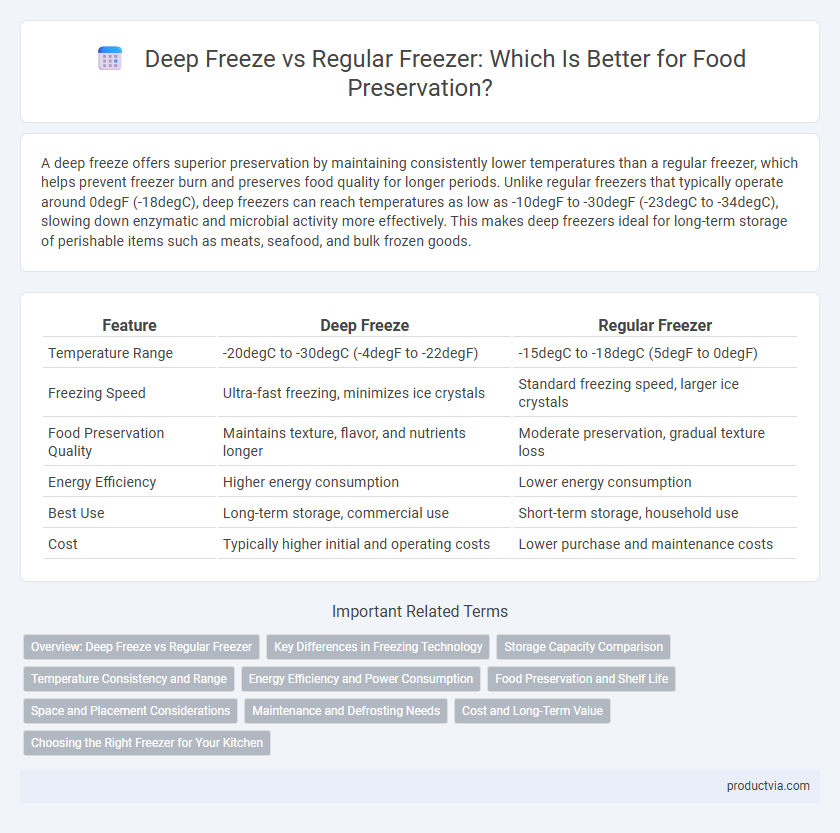A deep freeze offers superior preservation by maintaining consistently lower temperatures than a regular freezer, which helps prevent freezer burn and preserves food quality for longer periods. Unlike regular freezers that typically operate around 0degF (-18degC), deep freezers can reach temperatures as low as -10degF to -30degF (-23degC to -34degC), slowing down enzymatic and microbial activity more effectively. This makes deep freezers ideal for long-term storage of perishable items such as meats, seafood, and bulk frozen goods.
Table of Comparison
| Feature | Deep Freeze | Regular Freezer |
|---|---|---|
| Temperature Range | -20degC to -30degC (-4degF to -22degF) | -15degC to -18degC (5degF to 0degF) |
| Freezing Speed | Ultra-fast freezing, minimizes ice crystals | Standard freezing speed, larger ice crystals |
| Food Preservation Quality | Maintains texture, flavor, and nutrients longer | Moderate preservation, gradual texture loss |
| Energy Efficiency | Higher energy consumption | Lower energy consumption |
| Best Use | Long-term storage, commercial use | Short-term storage, household use |
| Cost | Typically higher initial and operating costs | Lower purchase and maintenance costs |
Overview: Deep Freeze vs Regular Freezer
Deep freezers maintain consistently lower temperatures, often below -18degC, enabling longer preservation of food by slowing microbial growth and enzymatic activity more effectively than regular freezers. Regular freezers typically operate around -18degC but experience temperature fluctuations due to frequent door openings, which can affect the quality and shelf life of stored items. Choosing a deep freeze ensures optimal food preservation for extended periods, especially for bulk storage and long-term freezing needs.
Key Differences in Freezing Technology
Deep freezers utilize ultra-low temperatures typically ranging from -18degC to -30degC, enabling faster freezing that preserves cellular structure and nutrient content more effectively than regular freezers, which operate around -18degC. Unlike regular freezers that use frost-free technology to prevent ice buildup, deep freezers often rely on manual defrosting, allowing for more stable temperature control and reduced freezer burn. The advanced cooling mechanisms in deep freezers maintain consistent temperatures, significantly enhancing long-term food preservation compared to the fluctuating cycles in standard models.
Storage Capacity Comparison
Deep freezers typically offer significantly larger storage capacities compared to regular freezers, making them ideal for bulk food preservation and long-term storage. While regular freezers generally range from 5 to 20 cubic feet, deep freezers can exceed 20 cubic feet, accommodating larger quantities of food items. This increased capacity supports better organization and reduces the frequency of restocking, optimizing food preservation efficiency.
Temperature Consistency and Range
Deep freezers maintain a significantly lower and more consistent temperature, typically ranging from -20degF to -40degF, which is ideal for long-term preservation of food, preventing freezer burn and nutrient loss. Regular freezers usually operate around 0degF with more temperature fluctuations, making them less effective for extended storage but suitable for everyday use. The superior temperature stability of deep freezers ensures optimal preservation of texture, flavor, and nutritional value over prolonged periods.
Energy Efficiency and Power Consumption
Deep freezers typically consume less energy compared to regular freezers due to their superior insulation and temperature retention capabilities. Their design focuses on maintaining a consistent low temperature with minimal power, resulting in lower electricity consumption over time. Regular freezers often cycle on and off more frequently, leading to higher power usage and reduced energy efficiency for long-term food preservation.
Food Preservation and Shelf Life
Deep freezers maintain a consistently lower temperature, typically below -18degC (-0.4degF), which significantly slows down enzymatic activity and microbial growth, extending food preservation and shelf life compared to regular freezers. Regular freezers usually operate around -15degC (5degF), which may not preserve food quality as effectively over long periods, leading to faster degradation and potential freezer burn. For optimal food preservation and prolonged shelf life, deep freezers are preferred due to their superior temperature stability and efficiency.
Space and Placement Considerations
Deep freezers offer larger storage capacity and vertical or chest designs that optimize space, making them ideal for bulk storage in basements or garages. Regular freezers are typically compact and integrated within refrigerators, suitable for limited kitchen spaces with easier accessibility. Selecting between deep freeze and regular freezer depends on available floor space, ventilation needs, and preferred placement within the home environment.
Maintenance and Defrosting Needs
Deep freezers require less frequent defrosting due to their superior insulation and stable low temperatures, reducing maintenance efforts compared to regular freezers. Regular freezers often need manual defrosting to prevent ice build-up that can impair cooling efficiency and increase energy consumption. Choosing a deep freezer for long-term preservation can minimize maintenance time and help maintain optimal freezing performance.
Cost and Long-Term Value
Deep freezers typically offer lower energy consumption and more consistent temperatures, making them cost-effective for long-term food preservation compared to regular freezers. Their design minimizes temperature fluctuations, which helps maintain food quality over extended periods, ultimately providing better long-term value despite a higher initial investment. Regular freezers often have faster cooling times but may incur higher electricity costs and less effective preservation for bulk storage.
Choosing the Right Freezer for Your Kitchen
Deep freezers maintain consistently lower temperatures, ideal for long-term preservation of bulk food items, preventing freezer burn and nutrient loss. Regular freezers integrated in refrigerators suit everyday storage needs with quicker access and moderate temperature settings. Selecting the right freezer depends on kitchen space, food storage frequency, and preservation duration, ensuring optimal freshness and energy efficiency.
Deep freeze vs Regular freezer for preservation Infographic

 productvia.com
productvia.com